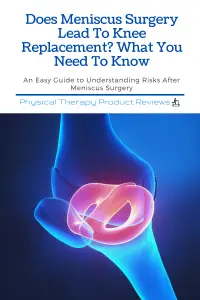Meniscus surgery is a surgical procedure to repair or remove the menisci in the knee. The menisci are C-shaped pieces of cartilage that act as “shock absorbers” for your knees. One of the most commonly performed arthroscopic surgeries in the US is a partial meniscectomy. However, recent research has questioned whether this surgery is beneficial for certain age groups.
This article will discuss if a meniscus surgery leads to a knee replacement, what are some tips to avoid a knee replacement after meniscus surgery, and if having a meniscus surgery leads to knee arthritis, and what you can do to help keep your knees healthy.
Does Meniscus Surgery Lead to Knee Replacement?
Yes, it can be in certain individuals and for certain types of Meniscus tears. If you are in middle-age between 45-79 years old and you have a degenerative meniscus tear then your chances of need a total knee replacement go up by 3-fold.
 The key here is the degenerative Meniscus Tear. This type of tear happens from wear and tear in the knee. There likely wasn’t one incident that caused the pain to happen but rather the pain started slowly and began to gradually increase over time. This type of tear is part of the normal arthritis process of the knee.
The key here is the degenerative Meniscus Tear. This type of tear happens from wear and tear in the knee. There likely wasn’t one incident that caused the pain to happen but rather the pain started slowly and began to gradually increase over time. This type of tear is part of the normal arthritis process of the knee.
In contrast, if you have an acute injury to the knee which causes the Meniscus to flip then this type of meniscus tear typically warrants surgery and does not have the same risk of developing arthritis or undergoing a knee replacement. An example of an acute knee injury might occur when you planted the leg and twisted or stepped in a hole and felt a pop in the knee.
Alternatives to Meniscus Surgery
If you are looking for alternatives to surgery for a torn Meniscus then there are a few options to consider. Instead of knee surgery, you should try conservative treatment first which includes physical therapy, activity modification, bracing, and even possible injections.
Physical Therapy For a Meniscus Tear
The primary alternative to Meniscus Surgery is Physical Therapy. The latest research shows that there is no statistical difference for middle-aged patients who have a partial meniscectomy knee surgery or those who go to physical therapy for a meniscus tear. In addition, there is no increased risk of developing arthritis and having to undergo a total knee replacement if you go to physical therapy.
The pain and limitation in the knee may not go away immediately with physical therapy or even during your active time in therapy. However, if you continue with your prescribed home program of exercises, over time the pain and limitations should slowly return to normal over a 2-year span and likely sooner.
Knee Bracing for a Meniscus Tear
If you have a Meniscus that is aggravated with certain activities at work or around the house then a good option to alter the pain cycle is to use a knee brace. The Shock Doctor knee brace can add extra support to the knee until the muscles of the leg can get strong enough and the pain is reduced.
A knee brace is not a long-term plan but should be viewed as a way to reduce pain and allow the body to do activities with less pain until the leg and knee can tolerate the activity without pain. For our favorite braces for a torn Meniscus, you can see our post here.
Activity Modification for Meniscus Tear
Activity Modification is something you should always start with for any type of meniscus tear. If your job involves activities that aggravate the knee then you need to limit those activities or work to find ways to modify that activity with less pain.
If certain household chores, yard work, or sports are hurting your knee then this needs to be modified as well. This can be as simple as using an insole in the shoe, using a pad to kneel on, or switching stance legs during work duties. The less the knee is aggravated during the day-to-day activity, the quicker it will return to normal levels.
Will you be the Same After a Meniscus Surgery?
In most cases, yes, you should return to normal after Meniscus surgery. After Meniscus surgery, you are likely to have some loss of motion in the knee and swelling which is normal immediately after surgery.
This is because part of the meniscus was removed that would normally cushion and facilitate movement during normal daily activities or sports. The good news however is that over time you’ll gradually improve so long as you keep up with your prescribed exercises from PT and give it time.
Most people have unrealistic expectations and expect their knee to be back to normal within 6-weeks. This is simply not enough time to let the knee heal fully or to build up the muscles around the knee. Those patients that give it time to heal and do their exercises usually return back to normal.
Signs that You Need Meniscus Surgery
Most meniscus tears do not need surgery. In fact, most meniscus injuries heal with conservative treatment such as physical therapy and activity modification techniques.
Signs that you may need surgery for a torn meniscus include:
- There is locking in the knee and you can’t bend or straighten it
- The leg gives our or collapses with certain movements and is a fall risk
- You’ve tried physical therapy, bracing, and allowed the knee to heal for 6 months or longer
Preventing a Total Knee Replacement After a Meniscus Surgery
The main thing that you can do to prevent having a total knee replacement after a Meniscus surgery is to be diligent with your home exercises and to be consistent with your recovery. This includes improving your range of motion, increasing your knee strength, and learning what activities to avoid in the short term.
Improving Knee Range of Motion After Meniscus Surgery
Improving your range of motion after meniscus surgery is important for making sure you get rid of the scar tissue and stretch out muscles that might tighten up. This helps keep the knee joint healthy and happy.
This is especially important to regain full knee extension after meniscus surgery. By regaining full knee extension you can more easily return to normal walking mechanics, and it helps spread forces across the knee joint more evenly during activity.
Improving Knee Strength After Meniscus Surgery
Strengthening the muscles around your knee surgery is very important to help rebuild function and return to activity. If you do not build up muscle strength then it can lead to long-term knee problems down the road, even after the surgery has healed.
It’s essential that you work at regaining quadriceps and hamstring muscle function post meniscus surgery. This is best done through dynamic activities such as lunges, squatting, and single-leg squatting, and balance activities.
Activities to Avoid after Torn Meniscus Surgery
It’s important to avoid certain activities and movements after meniscus surgery. This can be obvious for some activities as there will be high levels of pain. Some of the activities to be cautious of are sustained deep squatting, twisting while on one leg, and repetitive kneeling on the knee.
As far as other activities, there are certain things to avoid right after surgery such as running until you are further along the recovery process. However, that does not mean that running should be avoided forever.
Most activities do not need to be avoided forever but rather just need to be modified slightly. Modify the activity until you can perform it without pain.
Can You Have Multiple Meniscus Surgeries?
Multiple meniscus surgeries are not common and only happen in rare circumstances. For middle-aged patients, if the first meniscus surgery was not successful then there is a good chance that the second one won’t be either.
We recommend waiting for quite a while before attempting a second surgery as it can take over a year to fully recover from the first surgery and you won’t fully know if it is successful until then. In addition, giving physical therapy and your strengthening exercises a full year to be effective is recommended before doing any new surgery.
In the instances where someone has multiple Meniscus surgeries, this typically happens when there is a new tear or the old tear wasn’t fully removed and was torn further causing locking or catching in the knee. In these instances, you may need to have a second knee arthroscopy to allow the knee to work properly.
Conclusion
Meniscus surgery is a great way to improve the function and remove pain in your knee, but it isn’t always 100% effective. It’s important that you understand this before moving forward with meniscus surgery so that you aren’t surprised later on down the road if there are issues after meniscus surgery.
Most meniscus surgeries can lead to knee replacement in middle-aged patients. The main reason to undergo a Meniscus surgery is to fix a mechanical issue in the knee such as “locking” or “catching.” We recommend performing physical therapy as the best alternative and to see if you can make it to the 2-year mark before considering surgery for a Meniscus tear without locking.
How to Stay Active After Cervical Fractures: Expert Tips and Advice
Dealing with Painful Stairs After Ankle Replacement Surgery
Walking After a Total Ankle Replacement: Tips for a Successful Recovery
Exercises While Non-Weight Bearing After Ankle Replacement: Elevation, AROM, Leg Raises, and More
Ankle Pain with Stairs: Causes and Home Treatment Options
5 Common Mistakes You’re Making After an Ankle Sprain
Disclaimer: The information provided in this post is for educational purposes only. This is not a substitute for a medical appointment. Please refer to your physician before starting any exercise program.








